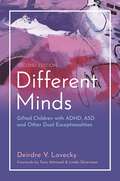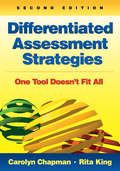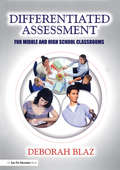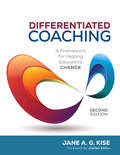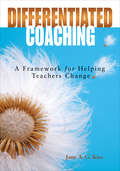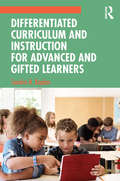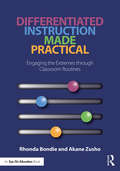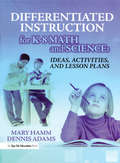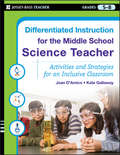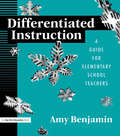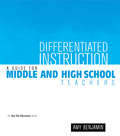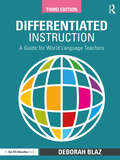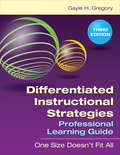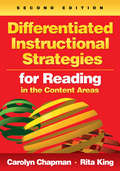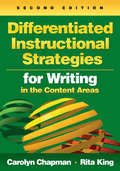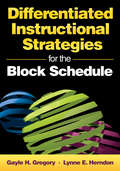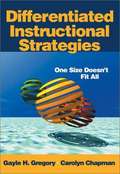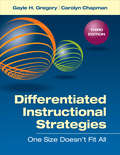- Table View
- List View
Different Minds: Gifted Children with AD/HD, Asperger Syndrome, and Other Learning Deficits
by Deirdre V LoveckyThrough recognizing the different levels and kinds of giftedness, this book provides an insight into the challenges and benefits specific to gifted children with attention difficulties. Explaining why certain children are gifted and how giftedness is manifested, each chapter on a specific topic addresses the relevance for children with AD/HD and Asperger Syndrome. Lovecky guides parents and professionals through methods of diagnosis and advises on how best to nurture individual needs, positive behavior and relationships at home and at school. Lovecky explores concepts such as asynchrony and the effects of such `uneven' development on children, using case studies to illustrate emotional, intellectual, creative and social development. She also highlights the inadequate measures currently in place to assist parents and teachers and goes on to clearly define what is required to understand and help these children so that their needs can be met more positively in the future. Different Minds, with its wealth of practical and background information, is essential reading for all those who live or work with gifted children with attention difficulties.
Different Minds: Gifted Children with ADHD, ASD, and Other Dual Exceptionalities, Second edition
by Deirdre V LoveckyIn this fully updated second edition, this book provides an insight into the challenges and benefits specific to gifted children with attention difficulties. Recognising the different kinds and levels of giftedness, it explains why certain children are gifted and how giftedness is manifested, with each chapter addressing the relevance of a specific topic for children with AD/HD and Asperger Syndrome. Lovecky guides parents and professionals through methods of diagnosis and advises on how best to nurture individual needs, positive behaviour and relationships at home and at school.Lovecky explores concepts such as asynchrony and the effects of such `uneven' development on children, using case studies to illustrate emotional, intellectual, creative and social development. She also highlights the inadequate measures currently in place to assist parents and teachers and goes on to clearly define what is required to understand and help these children so that their needs can be met more positively in the future. Different Minds, with its wealth of practical and background information, is essential reading for all those who live or work with gifted children with attention difficulties.
Differential Item Functioning
by Howard Wainer Paul W. HollandTest fairness is a moral imperative for both the makers and the users of tests. This book focuses on methods for detecting test items that function differently for different groups of examinees and on using this information to improve tests. Of interest to all testing and measurement specialists, it examines modern techniques used routinely to insure test fairness. Three of these relevant to the book's contents are: * detailed reviews of test items by subject matter experts and members of the major subgroups in society (gender, ethnic, and linguistic) that will be represented in the examinee population * comparisons of the predictive validity of the test done separately for each one of the major subgroups of examinees * extensive statistical analyses of the relative performance of major subgroups of examinees on individual test items.
Differentiated Assessment
by Deborah Meier Evangeline Harris StefanakisA comprehensive assessment system for working with underperforming studentsThis book describes a comprehensive assessment system especially appropriate for multilingual and "differentiated" classrooms with large numbers of underperforming students. Drawing from Multiple Intelligences theory, the approach is specifically aimed at helping teachers understand how each student learns and how best to tailor instruction to serve individual students' needs. Although the program makes use of conventional standardized tests and disability screenings, it places special importance on two approaches in particular: Student Portfolio Assessments and Personalized Learning Profiles.Provides detailed guidance and practical tools (including a DVD) for implementing successful portfolio and "profile" practices in the classroomIncludes real-world examples of model assessment programs from five schoolsExplains how to integrate assessment into the instructional process as well as how the portfolio program can be usedFormal profiles provide vital information about each student's cultural background, interests, strengths, and capabilities as well as their individual learning and language needs.
Differentiated Assessment Strategies: One Tool Doesn't Fit All
by Carolyn M. Chapman Rita S. KingBoost student achievement with easy-to-use formative assessment tools This new version of the bestseller provides research-based and practical formative assessment tools, strategies, and activities that simplify the process of identifying students’ strengths and needs. Updated features include a new chapter on exciting ways to engage learners in self-assessment; more tools for assessing before, after, and during learning; and approaches to help students take ownership of their own learning. The authors give teachers: Strategies for all grade levels and content areas; Tools for interpreting ongoing assessment data for immediate intervention and planning; Methods for determining learner preferences, cognitive styles, and multiple intelligences; Tips for establishing a positive environment for assessment.
Differentiated Assessment for Middle and High School Classrooms
by Deborah BlazThis book shows middle and high school teachers in differentiated classrooms how to integrate assessment into the teaching and learning process. With examples from real classrooms, this book demonstrates how to use a wide variety of assessment to better address the needs of your students with regard to their learning style, level of cognitive ability, skill level, interests, etc. Included are detailed examples of both formative and summative assessments.
Differentiated Coaching: A Framework for Helping Educators Change
by Jane A. KiseDifferentiate your coaching practice to meet the needs of every teacher! Jane Kise takes you on a journey into differentiated coaching with a strength-based framework for understanding, appreciating, and working with people who may think differently from you. Through an online self-assessment tool, you will discover how your strengths and beliefs influence your coaching practice. Through examples, case studies, and reflection exercises, you will understand how to: Tailor your coaching practices to meet the needs of each educator Increase teacher willingness to implement new skills in their classrooms Anticipate patterns of resistance and adjust both the content and delivery of professional development
Differentiated Coaching: A Framework for Helping Educators Change
by Jane A. KiseDifferentiate your coaching practice to meet the needs of every teacher! Jane Kise takes you on a journey into differentiated coaching with a strength-based framework for understanding, appreciating, and working with people who may think differently from you. Through an online self-assessment tool, you will discover how your strengths and beliefs influence your coaching practice. Through examples, case studies, and reflection exercises, you will understand how to: Tailor your coaching practices to meet the needs of each educator Increase teacher willingness to implement new skills in their classrooms Anticipate patterns of resistance and adjust both the content and delivery of professional development
Differentiated Coaching: A Framework for Helping Teachers Change
by Jane A. KiseDiscover how a coaching model based on teachers’ learning styles can impact student success! Help teachers understand how their strengths and beliefs may lock them into practices that can limit student success. The author uses research of personality, multiple intelligences, experiential learning models, and mind styles models to create a differentiated approach for staff development. Key elements include: Understanding teachers’ strengths and beliefs Providing information that can influence beliefs Meeting teachers’ needs during change Relating what is being learned to an existing problem
Differentiated Curriculum and Instruction for Advanced and Gifted Learners
by Sandra N. KaplanThis critical volume provides readers with a deep understanding of why and how to differentiate curriculum and instruction to better meet the academic, social, and emotional needs of advanced and gifted learners. Offering clear, constructure frameworks for learning, chapters focus on four key concepts – review, reinforce, refine, and redefine – which help readers create individualized learning experiences and differentiate standards-based curriculums. Filled with specific examples, lessons, and units of study, this essential guide emphasizes differentiation as a means to differ the What (curriculum) as well as the How (instruction) to successfully respond to the many facets of students’ giftedness.
Differentiated Early Literacy for English Language Learners: Practical Strategies
by Paul Boyd-BatstoneBoyd-Batstone (language and literacy, California State U. , Long Beach) offers strategies and activities that focus on meeting the early literacy demands of the No Child Left Behind Act. He differentiates the strategies according to five levels of language proficiency and includes writing strategies with assessment rubrics that match those levels. His suggestions address vocabulary development, the use of computer technology, and parental involvement.
Differentiated Instruction Made Practical: Engaging the Extremes through Classroom Routines
by Rhonda Bondie Akane ZushoNeed to decide when, why, and how to differentiate instruction in the classroom? Differentiated Instruction Made Practical introduces teachers to All Learners Learning Every Day (ALL-ED), an easy-to-use framework that enables tailored instruction for every learner. These unique, self-regulated learning routines were developed by an experienced K-12 teacher and researcher in collaboration with an educational psychology scholar. Filled with useful classroom examples, evaluation procedures, self-reflection activities, and relevant background information, this essential guide will help classroom teachers think on their feet and promote success for all students—not just the middle of the pack.
Differentiated Instruction Using Technology: A Guide for Middle & HS Teachers
by Amy BenjaminLike Amy Benjamin’s other books, this one is easy to read and simple to implement. It demonstrates that you can manage the complexities of differentiated instruction – and save time -- by using technology as you teach. It showcases classroom-tested activities and strategies which are easy to apply in your own classroom.
Differentiated Instruction for K-8 Math and Science: Ideas, Activities, and Lesson Plans
by Mary Hamm Dennis AdamsThis book offers practical recommendations to reach every student in a K-8 classroom. Research-based and written in a teacher-friendly style, it will help teachers with classroom organization and lesson planning in math and science. Included are math and science games, activities, ideas, and lesson plans based on the math and science standards. This book will help your students to develop positive attitudes and raise competency in math and science.
Differentiated Instruction for the Middle School Science Teacher
by Joan D'Amico Kate GallawayAn indispensable guide for middle school science teachers who have inclusive classrooms The third volume in the Differentiated Instruction series, Differentiated Instruction for the Middle School Science Teacher offers teachers proven techniques for designing and delivering effective science instruction, measuring success, getting students to work together, and collaborating with other professionals. The ready-to-use activities are tied to core curriculum standards for middle school students and each lesson incorporates adaptations for students with different learning needs. Includes strategies for teaching a standards-based science curriculum Contains a wealth of activities that can be adapted for learners of all abilities Offers information for delivering effective instruction, measuring success, and student collaboration The authors, both experienced teachers, offer a range of techniques, such as station/group activities, enrichment activities, and modifications for students with specific disabilities.
Differentiated Instruction: A Guide for Elementary School Teachers
by Amy BenjaminThis book demonstrates how to make your classroom more responsive to the needs of individual students with a wide variety of learning styles, interests, goals, cultural backgrounds, and prior knowledge. Focusing on grades K through 6, it showcases classroom-tested activities and strategies. Differentiated Instruction: A Guide for Elementary School Teachers shows you how to vary your instruction so you can respond to the needs of individual learners. The examples and classroom activities in this book focus on reading fiction, reading non-fiction, vocabulary, spelling, penmanship, map and globe skills, math, science, and the arts. Also included is coverage of differentiated instruction for English language learners, brain-based learning and multiple intelligences and the impact of differentiated instruction on high stakes testing.
Differentiated Instruction: A Guide for Middle and High School Teachers
by Amy BenjaminThis book demonstrates how to make your classroom more responsive to the needs of individual students with a wide variety of learning styles, interests, goals, cultural backgrounds, and prior knowledge. Focusing on grades 6 through 12, this book showcases classroom-tested activities and strategies. Differentiated Instruction: A Guide for Middle and High School Teachers shows you how to vary your instruction so you can respond to the needs of individual learners. The concrete examples in this book demonstrate how you can use differentiated instruction to clarify: the content (what you want students to know and be able to do) the process (how students are going to go about learning the content) and the product (how they will show you what they know.) This book is uniquely interactive. It features "Reflections" to help you understand your teaching style and guide you towards developing habits of mind which result in effective differentiated instruction. Also included is a chapter on teaching students whose native language is not English.
Differentiated Instruction: A Guide for World Language Teachers
by Deborah BlazIn the third edition of a bestseller, author Deborah Blaz helps you differentiate lessons for your world language students based on their learning styles, interests, prior knowledge, and comfort zones. This practical book uses brain-based teaching strategies to help students of all ability levels thrive in a rigorous differentiated learning environment. Each chapter provides classroom-tested activities and tiered lesson plans to help you teach vocabulary, speaking, listening, reading, and writing in world language classes in ways that are interactive, engaging, and effective for all learners. Features new to this edition include: activities aligned with the latest ACTFL and CEFR standards ideas and activities for project-based learning, virtual learning, and learning with digital tools, such as ChatGPT up-to-date latest guidance on learning styles and using variety in teaching more photocopiable forms, checklists, and handouts for suggested activities You’ll also learn how to differentiate assessment effectively to help all students show their full potential. Classroom-ready tools and templates can be downloaded as free support material from our website (www.routledge.com/9781032258287) for immediate use.
Differentiated Instruction: A Guide for World Language Teachers
by Deborah Blaz• Updated with new tools and easy-to-implement strategies throughout • New emphasis on teaching online and using digital tools • Addresses differentiation in all areas of language teaching, from grammar to vocabulary to culture
Differentiated Instructional Strategies Professional Learning Guide: One Size Doesn't Fit All
by Gayle H. GregorySupport differentiated instruction schoolwide with this expert guide! The best-selling Differentiated Instructional Strategies: One Size Doesn’t Fit All has been revised to include new strategies and a Common Core lesson-planning template—and this workshop-friendly professional learning guide remains the ideal accompaniment. Inside you’ll find step-by-step training activities for job-embedded professional development, guidelines for small study groups and larger staff development meetings, and: Guidance for individualized support and mentoring Suggestions for evaluation, coaching, observation, and supervision of differentiated instructional practices Research-based responses to concerns about change Implementation and evaluation tools to measure schoolwide progress Resources for implementing large-scale differentiation initiatives
Differentiated Instructional Strategies for Reading in the Content Areas
by Carolyn M. Chapman Rita S. KingIncrease understanding of content by strengthening every learner’s reading skills! Featuring new strategies, updated research, expanded coverage of key topics, plus new material on English language learners, this revised edition offers substantive methods for increasing content learning by helping students become better readers. The authors explain how differentiated instruction, multiple intelligences, scaffolding, and other techniques can support reading comprehension, and help teachers: Create the right reading environment Assess readers effectively Incorporate guided reading, shared reading, the four-block model, language experience, and read-alouds Teach vocabulary using methods such as visuals, context clues, and miscue analysis Improve comprehension before, during, and after reading
Differentiated Instructional Strategies for Writing in the Content Areas
by Carolyn M. Chapman Rita S. KingUse writing as a tool for helping students master content! This updated edition of a best-selling book offers explicit strategies for differentiating writing instruction to help students learn content and develop as writers. The authors address how to create a climate for writing, use flexible groupings, differentiate instruction, and assess student writing. Offering new strategies and activities for effective writing instruction, this second edition: Covers informational text writing and critical thinking skills Includes guidance for working with English language learners Discusses current research about writing and learning Offers expanded coverage of assessment methods and tools
Differentiated Instructional Strategies for the Block Schedule
by Gayle H. Gregory Lynne E. HerndonEliminate "idea block" with this practical resource that includes more than 100 planning tools, matrixes, rubrics, templates, and choice boards for differentiating instruction during extended learning blocks.
Differentiated Instructional Strategies: One Size Doesn't Fit All
by Carolyn Chapman Gayle H. GregoryHere is the practical process teachers can use to adjust learning based on individual students' knowledge, skills, experience, preferences, and needs.
Differentiated Instructional Strategies: One Size Doesn't Fit All
by Gayle H. Gregory Carolyn M. ChapmanYour favorite differentiated instruction text just got better! If you're in need of a single resource to put differentiated instruction immediately into practice, then follow the lead of 100,000+ teachers and look to Gregory and Chapman's ground-breaking text. With new strategies, updates throughout, a Common Core lesson-planning template, and a larger format, the third edition is an even richer resource with: A deep research base coupled with immediately useable examples A start-to-finish six-step process, beginning with establishing a classroom climate, then getting to know students An emphasis on formative assessment before, during, and after learning 70+ templates, tools, and questionnaires

